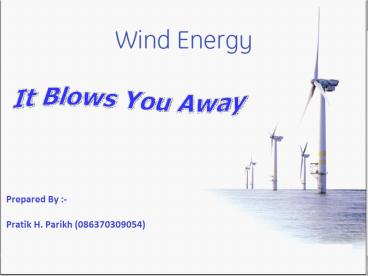electricity from wind power - PowerPoint PPT Presentation
Title:
electricity from wind power
Description:
non conventional energy source – PowerPoint PPT presentation
Number of Views:11903
Title: electricity from wind power
1
It Blows You Away
2
- "Coal, gas and oil will not be the three kings of
the energy world for ever. It is no longer folly
to look up to the sun and wind, down into the
sea's waves"
3
Introduction
- Energy is a major input for overall
socio-economic development of any society - The prices of the fossil fuels steeply increasing
- So renewables are expected to play a key role
- Wind energy is the fastest growing renewable
- Wind turbines are up to the task of producing
serious amounts of electricity
4
Uneven heating of earths surface and rotation
Principles
5
Power vs. Velocity
6
Solidity and Tip speed ratio
7
Potential
- Huge potential exists
- Available potential can contribute five times the
world energy demand - 0.4 contribution to total energy
8
Wind is currently the worlds fastest growing
energy source
9
(No Transcript)
10
Installed Capacity (MW) in 2005
11
Available potential in India
12
All India Fuel wise Installed Capacity, 2004
13
State wise potential in India, 2005
14
Turbine Evolution
Technology
- Used for
- Pumping water
- Grinding grain
- Mainly used for
- Generating Electricity
15
Types of turbines
- VAWT
- Drag is the main force
- Nacelle is placed at the bottom
- Yaw mechanism is not required
- Lower starting torque
- Difficulty in mounting the turbine
- Unwanted fluctuations in the power output
16
- HAWT
- Lift is the main force
- Much lower cyclic stresses
- 95 of the existing turbines are HAWTs
- Nacelle is placed at the top of the tower
- Yaw mechanism is required
17
Two types of HAWT
DOWNWIND TURBINE
UPWIND TURBINE
18
- Counter Rotating HAWT
- Increase the rotation speed
- Rear one is smaller and stalls at high wind
speeds - Operates for wider range of wind speeds
19
Offshore turbines
- More wind speeds
- Less noise pollution
- Less visual impact
- Difficult to install and maintain
- Energy losses due long distance transport
20
A Typical HAWT
21
Turbine design and construction
- Blades
- Material used
- Typical length
- Tower height
- Heights twice the blade length are found
economical
22
- Number of blades
- Three blade HAWT are most efficient
- Two blade turbines dont require a hub
- As the number increases noise, wear and cost
increase and efficiency decreases - Multiple blade turbines are generally used for
water pumping purposes
23
- Rotational control
- Maintenance
- Noise reduction
- Centripetal force reduction
- Mechanisms
- Stalling
- Furling
24
- Yaw Mechanism
- To turn the turbine against the wind
- Yaw error and fatigue loads
- Uses electric motors and gear boxes
- Wind turbine safety
- Sensors controlling vibrations
- Over speed protection
- Aero dynamic braking
- Mechanical braking
25
Improvements
- Concentrators
26
Determining Factors
Economics
- Wind Speed
- Turbine design and construction
- Rated capacity of the turbine
- Exact Location
- Improvements in turbine design
- Capital
27
Wind Speed Matters
Assuming the same size project, the better the
wind resource, the lower the cost.
28
Size Matters
Assuming the same wind speed of 8.08 m/s, a large
wind farm is more economical
29
Overall cost distribution
30
Break down of capital cost
31
Energy Cost Trend
1979 40 cents/kWh
2000 4 - 6 cents/kWh
- Increased Turbine Size
- RD Advances
- Manufacturing Improvements
2004 3 4.5 cents/kWh
32
Typical cost statistics
- Size 51 MW
- Wind Speed 13-18 miles/hour
- Capital cost 65 million (1300/MW)
- Annual production 150 million kW-hr
- Electricity costs 3.6-4.5 cents
- Payback period 20 years
33
Economic Advantages
- Greater fuel diversity
- No delay in construction
- Low maintenance costs
- Reliable and durable equipment
- Additional income to land owners
- More jobs per unit energy produced
- No hidden costs
34
(No Transcript)
35
So..
- Price of wind power is coming down
- There is enormous capacity
- Energy storage, however, is still a problem
36
Typical Concerns
- Visual impact
- Off shore turbines
- Arrangement
- Avian concerns
- Suitable choice of site
- Using tubular towers instead of lattice tower
- Using radars
37
- Noise
- Varies as 5th power of relative wind speed
- Streamlining of tower and nacelle
- Acoustic insulation of nacelle
- Specially designed gear box
- Use of upwind turbines
- Reducing angle of attack
- Low tip speed ratios
38
- Changes in wind patterns
- Reducing turbulence
- Intermittent
- Coupling with hydro or solar energy
- TV, microwave, radar interference
- Switching from conducting material to
non-conducting and composite material
39
Conclusion
- Wind energy is pollution free and nature friendly
- Wind energy has very good potential and it is the
fastest growing energy source - The future looks bright for wind energy because
technology is becoming more advanced and
windmills are becoming more efficient
40
Any questions ????
THANK YOU































